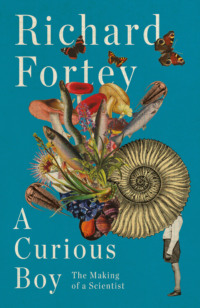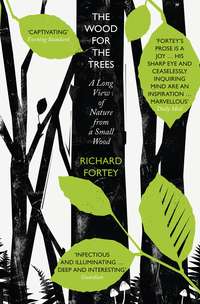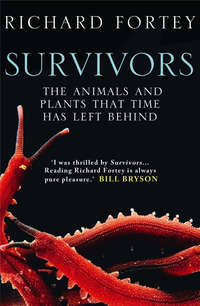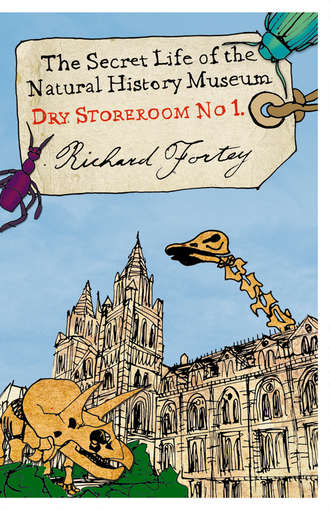
Полная версия
Dry Store Room No. 1: The Secret Life of the Natural History Museum

RICHARD FORTEY
Dry Store Room No. 1
The Secret Life of
the Natural History Museum


Dedication
To Leo, with my love
CONTENTS
Cover
Title Page
Dedication
Acknowledgements
1 Behind the galleries
2 The naming of names
3 Old Worlds
4 Animalia
5 Theatre of Plants
6 Multum in parvo
7 Museum rocks
8 Noah’s Ark in Kensington
9 House of the Muses
Further Reading
Index
About the Author
Photographic Insert
Praise
By the same author
Copyright
About the Publisher
Acknowledgements
I am indebted to many friends and colleagues in the Natural History Museum for sharing their oral histories with me, often in return for no more than a good lunch. Any errors that appear in this book are entirely the fault of the author, who may have not been the best of scribes, and nothing to do with those at lunch. I apologize to those who gave me stories that I failed to use: there was no shortage of material. I apologize even more sincerely to those who still have not received their lunch. I should particularly mention the following (in no particular order): Edmund Launert, Sandra Knapp, Peter Hammond, Dick Vane-Wright, Victor Eastop, Martin Hall, Steve Brooks, Andrew Polaszek, Paul Eggleton, David Reid, John Taylor, David Johnson, Vaughan Southgate, Amoret Whitaker, Jenny Bryant, Linda Irvine, Bob Press, Robert Symes, Richard Her-rington, Alan Hart, Paul Taylor, Hugh Owen, Ellis Owen, Angela Milner, Cyril Walker, Ollie Crimmen, Ron Croucher, Chris Stringer, Andrew Currant, Alex Ball, Sara Russell, Frances Wall, Chris Stanley, Bob Hutchison, Rowland Whitehead, Klaus Sattler, Kathy Way and Lorraine Cornish. Polly Tucker helped greatly with making Museum archives available to me. Thanks also to Katie Anderson in the Natural History Museum Picture Libary. Heather Godwin gave her usual eagled-eyed attention to the first draft, and removed several bad jokes. Robin Cocks read through the manuscript. Jackie Fortey gave indispensable help with picture research. Annabel Wright and Gail Lynch at HarperCollins were charming and patient editors, and Vera Brice was a fantastic designer.
1

Behind the galleries

This book is my own store room, a personal archive, designed to explain what goes on behind the polished doors in the Natural History Museum. All our lives are collections curated through memory. We pick up recollections and facts and store them, often half forgotten, or tucked away on shelves buried deep in the psyche. Not everything is as blameless as we might like. But the sum total of that deep archive is what makes us who we are. I cannot escape the fact that working for a whole lifetime within the extravagant building in South Kensington has moulded much of my character. By the same token, I also know the place rather better than any outsider. I am in a position to write a natural history of the Natural History Museum, to elucidate its human fauna and explain its ethology. There are histories that deal with the decisions of the mighty, and there are histories that are concerned with the ways of ordinary people. An admirable history of the Natural History Museum as an institution, by William T. Stearn, was published in 1981. What Stearn largely left out was an account of the achievements, hopes and frustrations, virtues and failings of the scientists who occupied the ‘shop floor’ – the social history, if you like. My own Dry Store Room No. 1 will curate some of the stories of the people who go to make up a unique place. I believe profoundly in the importance of museums; I would go as far as to say that you can judge a society by the quality of its museums. But they do not exist as collections alone. In the long term, the lustre of a museum does not depend only on the artefacts or objects it contains – the people who work out of sight are what keeps a museum alive by contributing research to make the collections active, or by applying learning and scholarship to reveal more than was known before about the stored objects. I want to bring those invisible people into the sunlight. From a thousand possible stories I will pick up one or two, just those that happen to have made it into my own collection. Although I describe my particular institution I dare say it could be a proxy for any other great museum. Perhaps my investigations will even cast a little light on to the museum that makes up our own biography, our character, ourselves.
At first glance the Natural History Museum looks like some kind of cathedral, dominated by towers topped by short spires; these lie at the centre of the building and at its eastern and western corners. Ranks of round-topped Romanesque windows lie on ‘aisles’ connecting the towers which confirm the first impression of a sacred building. Even on a dull day the outside of the Museum shows a pleasing shade of buff, a mass of terracotta tiles, the warmth of which contrasts with the pale stucco of the terraces that line much of the other side of the Cromwell Road. Courses of blue tiles break up the solidity of the façade. The entrance to the Museum is a great rounded repeated arch, flanked by columns, and the front doors are reached by walking up a series of broad steps. Arriving at the Natural History Museum is rather like entering one of the magnificent cathedrals of Europe, like those at Reims, Chartres or Strasbourg. The visitor almost expects to hear the trilling of an organ, or the sudden pause of a choir in rehearsal. Instead, there is the cacophony of young voices. And where the Gothic cathedral will have a panoply of saints on the tympanum above the door, or maybe carvings of the Flight from Egypt, here instead are motifs of natural history – foliage with sheep, a wolf, a muscled kangaroo.
The main hall still retains the feel of the nave of a great Gothic cathedral, because it is so high and generously vaulted. But now the differences are obvious. High above, where the cathedral might display flying buttresses, there are great arches of steel, not modestly concealed, but rather flaunted for all they are worth. This is a display of the Victorian delight in technology, a celebration of what new engineering techniques could perform in the nineteenth century. Elsewhere in the Natural History Museum, a steel frame is concealed beneath a covering of terracotta tiles that completely smother the surface of the outside and most of the inside of the building; these paint the dominant pale-brown colour. Only in the hall are the bones exposed. This could have created a stark effect, but is softened by painted ceiling panels; no angels spreadeagled above, but instead wonderful stylized paintings of plants. It does not take a botanist to recognize some of them: here is a Scots pine (Pinus sylvestris),* there is a lemon tree (Citrus limonum), but how many Europeans would recognize the cacao plant (Theobroma cacao)? Many visitors, and most children, don’t even notice these charming ceiling paintings. Their attention is captured by other bones: the enormous Diplodocus dinosaur that occupies the centre of the ground floor, heading in osteological splendour towards the door. Its tiny head bears a mouthful of splayed teeth in a grinning welcome.
The Diplodocus has been there a long time. It is actually a cast of an original in Pittsburgh, which was assembled in the Museum during 1905. The great philanthropist Andrew Carnegie presented the specimen to King Edward VII who then handed it over to the Museum in person at a grand public occasion. Diplodocus was proudly in place when I first came to the Natural History Museum as a little boy in the 1950s, and it was still there when I retired in 2006. I am always glad to see it; not that I regard a constructed replica of an ancient fossil as an old friend, it is just consoling to pass the time of day with something that changes little in a mutable world.
But Diplodocus has changed, albeit rather subtly. When I was a youngster, the enormously long Diplodocus tail hung down at the rear end and almost trailed along the floor, its great number of extended vertebrae supported by a series of little props. This arrangement was not popular with the warders, as unscrupulous visitors would occasionally steal the last vertebra from the end of the tail. There was even a box of ‘spares’ to make good the work of thieves so that the full backbone was restored by the time the doors opened the following day. Visitors today will see a rather different Diplodocus: the tail is elevated like an extended whip held well above the ground, supported on a brass crutch which has been somewhat cruelly compared with those often to be found in the paintings of Salvador Dalí; now the massive beast has an altogether more vigorous stance. The skeleton was remodelled after research indicated that the tail had a function as a counterbalance to the extraordinarily long neck at the opposite end of the body. Far from being a laggard, Diplodocus was an active animal, despite the smallness of its brain. Nowadays, all the huge sauropod dinosaurs in films such as Jurassic Park show the tail in this active position. Many exhibits in a natural history museum are not permanent in the way that sculptures or portraits are in an art gallery. Bones can be rehung in a more literal way than paintings.
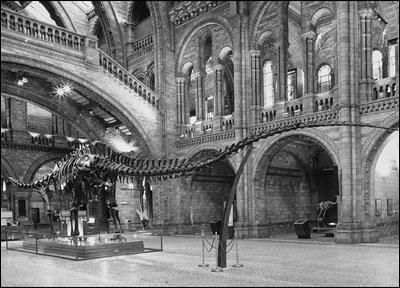
Diplodocus carnegii, the giant plant-eating dinosaur, with its tail uplifted. The Diplodocus skeleton was moved to its present position in the main hall from the former reptile gallery in 1979.
Diplodocus carnegii. Photo © Natural History Museum, London.
Now animatronic dinosaurs flash their teeth and groan, and carry us back effectively to the Cretaceous period, a hundred million years ago. Small children shelter nervously behind the legs of their parents. ‘Don’t worry,’ say the parents, ‘they aren’t real.’ The kids do not always look convinced. The bones that caused such a sensation in Andrew Carnegie’s time a century ago, and that still command attention in the main hall, are now sometimes considered a little too tame. There is, to my mind, still something eloquent about the Diplodocus specimen: not merely its size, but that it is the assembled evidence for part of a vanished world. All those glamorous animations and movie adventures rely ultimately on the bones. A museum is a place where the visitor can come to examine evidence, as well as to be diverted. Before the exhibitions started to tell stories, that was one of the main functions of a museum, and the evidence was laid out in ranks. There are still galleries in the Natural History Museum displaying minerals, the objects themselves – unadorned but for labels – a kind of museum of a museum, preserved in aspic from the days of such systematic rather than thematic exhibits. Few people now find their way to these galleries.
The public galleries take up much less than half of the space of the Natural History Museum. Tucked away, mostly out of view, there is a warren of corridors, obsolete galleries, offices, libraries and above all, collections. This is the natural habitat of the curator. It is where I have spent a large part of my life – indeed, the Natural History Museum provides a way of life as distinctive as that of a monastery. Most people in the world at large know very little about this unique habitat. This is the world I shall reveal.
I had been a natural historian for as long as I could remember and I had always wanted to work in a museum. When there was a ‘career day’ at my school in west London I was foolish enough to ask the careers master, ‘How do you get into a museum?’ The other boys chortled and guffawed and cried out, ‘Through the front door!’ But I soon learned that it would not be that easy. Getting ‘into a museum’ as a researcher or curator is a rather arduous business. A first degree must be taken in an appropriate subject, geology in my case, and this in turn followed by a PhD in a speciality close to the area of research in the museum. When I applied for my job in 1970 this was enough, but today the demands are even greater. A researcher must have a ‘track record’, which is a euphemism for lots of published scientific papers – that is, articles on research printed in prestigious scientific journals. He or she must also be described in glowing terms by any number of referees; and, most difficult of all, there must be the prospect of raising funds from the rather small number of public bodies that pay out for research. It is a tall order. Even so, the most important qualification remains what it always was: a fascination and love for natural history. There is no other job quite like it.
The interview for my job was conducted in the Board Room. It was 1970. To reach the rather stern room on the first floor of the Natural History Museum I had passed through several sets of impressive mahogany doors. A large and very polished table was in the middle of the room, the kind of table that is always associated with admonishment. On one wall there was and still is a splendid portrait of the first Director of the Museum, the famous anatomist Sir Richard Owen, by Holman Hunt. He was an old man when he sat for the portrait, and is dressed in a brilliant scarlet robe, beautifully painted to show the glint of satin, indicative of some very superior doctorate. His glittering eyes survey the room, intent on not tolerating fools gladly. Each candidate was interviewed by the Keeper of Palaeontology – who was the head of the appropriate department – and his Deputy Keeper, together with the Museum Secretary, Mr Coleman. The Secretary was a rather grand personage at that time, who more or less ran the museum from the administrative side. There was also a sleepy-looking gentleman from the Civil Service Commission, who was there for some arcane purpose connected with the fact that the successful candidate would be paid out of the public purse. I was dressed in my best, and indeed only, suit and very nervous.
I was applying to be the ‘trilobite man’ for the Museum. The previous occupant of the post was Bill Dean, who had gone off to join the Geological Survey of Canada. He left behind a formidable reputation. Trilobites are one of the largest and most varied groups of extinct animals, and being paid to study them is one of the greatest privileges in palaeontology. I had not yet completed my PhD thesis, and was young and inexperienced. My fellow candidates were ahead of me by a few months or years. We would all get to know one another well over the course of our professional lives, but for the moment conversation was restricted to twitchy pleasantries. We sat on uncomfortable chairs in a kind of corridor and awaited our turn in the Board Room. Eventually, I had to go in to face the piercing eyes of Sir Richard. The questioning began. Fortunately, I had made some interesting discoveries in the Arctic island of Spitsbergen where I had been carrying out my PhD research at Cambridge University, so once I got going I had a lot to talk about, and my general air of nervousness began to subside. I had discovered all kinds of new trilobites in the Ordovician* age rocks there, and studying these animals seemed a matter of pressing excitement. Youthful enthusiasm can occasionally count for more than mature wisdom. The man from the Civil Service Commission stirred himself once and asked if I played any sport. The answer was no, except for tiddlywinks. He then sank back into apparent torpor. The Keeper smiled at me benignly. Hands were shaken, and it was all over. Did I imagine something less severe in Sir Richard Owen’s expression as I left the Board Room?
Several weeks later I was offered the job. In view of my youth I was taken on as a Junior Research Fellow, which meant, I think, that if I did not work out I could be politely escorted out of the cathedral. But important to me was that I was entitled to go behind the mahogany doors into the secret world of the collections, and to receive a modest salary for doing so. I was being paid to do work that I would have done for nothing. I had a season ticket to a world of wonders.
To trace my journey behind the scenes, follow me along one of the few galleries remaining from the old days of the Museum, one flanked by a high wall lined with cases bearing the fossils of ancient marine reptiles: ichthyosaurs and plesiosaurs. They look as if they are swimming along this wall, one above the other, making a kind of Jurassic dolphin pod (although of course they are not biologically related to those similar-looking living mammals). They comprise a famous collection, including some specimens that are the basis of a fossil species name. One of the ichthyosaurs probably died in the process of giving birth to live young, although few visitors notice the label explaining this curious and fascinating fact. Several of the skeletons were dug out by the pioneer fossil collector Mary Anning, who was one of very few women scientists in the first half of the nineteenth century; on summer afternoons an actress may play the part of Miss Anning on the gallery, much to the bemusement of Japanese visitors who think she must be selling something. At the end of the gallery stands the skeleton of a giant sloth from South America, geologically very much younger than the ichthyosaurs. This fine specimen is routinely mistaken for a dinosaur by the more desultory Museum visitors, but it is a mammal, albeit of a special and monstrous kind. Behind the sloth there is a door. And behind the door lies the Department of Palaeontology, home of the really old fossils.
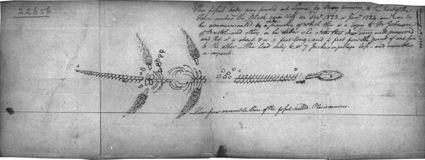
Pen-and-ink drawing of a Jurassic plesiosaur made by pioneer fossil collector Mary Anning in 1824.
Plesiosaur drawn by Mary Anning, 1824. Photo © Natural History Museum, London.
The door opens with a special key. When I first joined the Museum, the keys were issued every day from a key pound staffed by a warder. Every department had a coloured disc attached to the key, a different colour for Botany, Palaeontology, the Office, or whatever. Each member of staff had an individual number. So when I arrived at the key pound in the morning I had to cry out ‘47 Grey!’ and within a few seconds I would be handed my keys by a uniformed warder. When a member of staff became well known to the warder, the arrival of the right keys might anticipate the hollering. The keys were massive, old-fashioned steel affairs such as you might expect to be carried by a ‘screw’ in a prison, or by a miser to open an antique oak chest, and they turned in the locks with a satisfying clunk. There was a specialist locksmith hidden away somewhere in the bowels of the Museum, whose job it was to oil the locks, and keep the keys turning. I soon learned that had I attempted to get into the room where the precious gems were stored I would have discovered that my keys would not fit into that particular lock. There were hierarchies of trust. Presumably only the Director had keys that worked in every lock. We were instructed to keep the keys on our person at all times. Graven into the metalwork were the words ‘20 shillings reward if found’, a measure of the antiquity of the keys, since even in the early 1970s a quid was not much of a reward. From time to time the Secretary would tour the Museum to see which naughty boys and girls had left their keys upon their desks while they went off for a cup of tea, and a ticking-off from above by means of a pompous memorandum would follow. An even worse crime was unwittingly to walk out of the Museum bearing the precious keys. At the end of the working day, the warder could spot a miscreant by an unfilled space in the ranks of keys. Forgetful members of staff were commanded to come back late at night from Brighton or East Grinstead to restore their keys to the hook. A dressing-down would follow from the head of department the following day. The locks were changed in the 1980s to modern Yale varieties, but the new keys were still tailored to different security needs, so I still cannot get to steal the diamonds. By one of those weird volte-faces that only bureaucratic institutions can manage, it is now against the rules to fail to take the keys home with you.
Let us go through the doors to the collections. They are housed in a long gallery, across which run banks of cabinets, each some ten yards or so long. There are fifty-seven such banks on the ground floor of the Palaeontology Department, every cabinet neatly sealed by a sliding door designed to keep out the dust. Most of the doors are locked as they are supposed to be. But there is one that has obviously not been sealed away. Carefully slide open the door, and there lies revealed a series of a dozen or so mahogany drawers inside each cabinet. There are labels attached to the middle of the drawers, any one of which might be deeper than the typical cutlery drawer at home. A curator has written a scientific name of an animal in a neat hand on the label, together with some locality information. Pull open the drawer and peer inside: it slides easily on metal runners. There are white cardboard trays on which rest a number of what are evidently bones of various kinds. Even without specialist knowledge it is possible to recognize teeth of several varieties, alongside fragments of limb bones. One of the teeth is a massive affair, a kind of ribbed washboard on a massive bony base – this is completely characteristic of the elephant family, a monument of masticatory might. These teeth allow elephants to crush tough vegetation of many kinds. All the bones and teeth are more or less stained a yellowish colour. And all of them are fossils, retrieved from the ground by searching strata, digging or scraping in quarries or cliffs; they have acquired the stain of time from their long interment of several hundred thousand years, possibly as a result of the action of iron-rich fluids. Every fragment, no matter how unspectacular it is, tells a story about past time, each one is a talisman for unlocking history. The specimens in this drawer are all fossil mammals, distant cousins of the sloth that guards the entrance to the department.
The collections in this particular part of the Museum and in this particular aisle are devoted to vertebrates from the geologically recent period known as the Pleistocene, a time slice that includes the last ice ages. Inside the tray on which each fossil rests there is a neatly written label which tells us that this particular collection was derived from the cliffs at Easton Bavents, near Southwold in the county of Suffolk, a place where the sea is eroding some of the youngest rocks in Britain, though they are still over a million years old. Sharp-eyed local collectors had spotted these organic remains as winter storms excavated them from the soft sandy cliffs. Had they not been collected and housed in a museum, a few seasons of weathering on those harsh shores would have reduced the bones to meaningless rubble. So the Museum provides a way of cheating decay, of sequestering information from the degradations of time. Doubtless, each specimen provoked a thrill of recognition in its discoverer, the satisfaction of a search rewarded. This single drawer preserves the record of days of endeavour and an archive of pleasure in discovery, or secret gloating over finding the best specimens of the season. Each bone could tell a story of the relative roles of luck and perseverance in science. Fossil fragments have an eloquence that belies their yellowish uniformity. Perhaps the observer will feel a twinge of disappointment at the incompleteness of the specimens, having seen reconstructions in books and films of whole animals striding about the landscape. These remains are just scraps, bits and pieces, odds and ends. The truth is that much fossil material is like this. The skill of the scientist often lies in being able to identify small pieces of a whole animal: from tooth to elephant. Every morsel of the past is useful.


